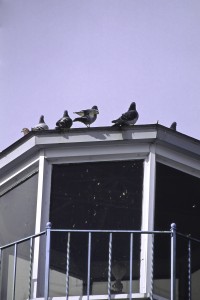An essential part of eliminating pest pigeons is safety-centric, pre-environmental and postenvironmental cleanup of biological waste. Effective interventions result in satisfied customers and recurring revenue.
■ Do incorporate a requirement within any bird management program to periodically inspect for accumulated bird droppings on or near structures.
■ Do train facilities maintenance staffs to look for bird droppings as part of their normal inspection and preventive maintenance duties.
■ Do observe air-handling system introduction locations to minimize the potential for bird droppings to create an indoor air quality exposure hazard for building occupants. (Shut down and seal off before cleaning up.)
■ Do have a protocol for removing bird droppings during minimal building occupancy (weekends or periods of minimal building usage).
■ Do use barricades and caution signage during all operations to keep the public away from work areas.
■ Do use a low-velocity spray mist on wet droppings before cleanup.
■ Do allow only healthy (not immune-compromised) individuals to clean droppings.
■ Do disinfect all tools used to clean with a 10% bleach solution.
■ Don’t digitally handle dead birds; use a tool. Treat each carcass as if it’s contaminated with disease.
■ Don’t create and inhale dust from bird droppings.
■ Don’t eat, drink or smoke while cleaning.
■ Don’t allow coworkers to wear anything less than high-efficiency-particulate-air/HEPA-filtered respirators approved by the National Institute for Occupational Safety and Health — N100 or N95 series at a minimum.
■ Don’t allow employees to wear substandard personal protective equipment. Mandate goggles that are disinfected with a 10% bleach solution, plus disposable coveralls, gloves, boots and hats.
■ Don’t allow employees to remove respirators until all other contaminated, disposable items have been placed in plastic bags.
■ Don’t allow bird droppings and contaminated disposable items to be placed in anything less than securely closed, double plastic bags, tagged as infectious waste, placed into Dumpsters for transport and landfill disposal, or disposed of per local regulations.
■ Don’t violate any standards. See 29 CFR – Part 1910 – Occupational Safety and Health Standards.
Most Wanted
Classified scientifically as Columba livia, meaning olive dove, pigeons are becoming increasingly recognized as a reservoir for and means of disease transmission. Feral pigeons assault buildings through their presence and waste. Their excreta are voluminous — with green, brown and yellow centralized material well spread within a loose packeting — and desiccate to a hard consistency. Pigeon droppings, or avian dejecta, contain fecal and urate mixtures. Dropped onto a hard surface, excreta spread out into a large area. The extremely acidic material defaces buildings, marble surfaces, limestone and motor vehicles.
In addition to damaging cars and buildings, feral pigeons can be sources of abundant ectoparasites through their activity and nesting sites. Such co-conspirators include bed bugs, fleas, ticks and mites. In turn, such extended exposures can produce allergic reactions in people.
As if that weren’t enough, they’re also a threat to public health. Feral pigeons harbor histoplasmosis, an infection occurring in humans and other animals as a result of interaction with the fungus Histoplasma capsulatum. The disease typically is contracted by the inhalation of dust containing fungal spores.
Dr. Mitchell, D.O., Ph.D., M.P.H., B.C.E., a board-certified physician and entomologist, is principal technical specialist for PestWest Environmental, as well as PMP’s Technical Editor. He can be reached at docmitchell@northcoastmedia.net or 515-333-8923.

Leave A Comment